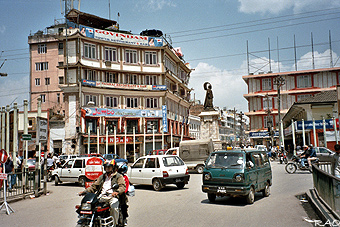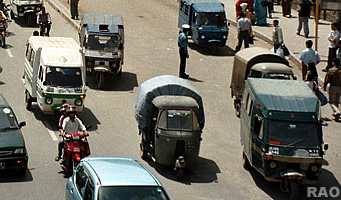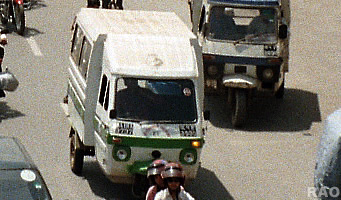 |
Nepal Environment |
|
|
 |
|
Bleak
Outlook for Environment in Kathmandu Valley
|
|
Concerted
Effort Needed to Check Negative Impacts
|
 |
Kathmandu's
growth could be severely compromised unless effective measures are taken
to stem the tide of environmental degradation resulting from economic and
human pressures, according to the Kathmandu Valley Environmental Outlook
released today during the 10th Governing Council Meeting and Silver Jubilee
of the South Asia Cooperative Environment Programme (SACEP). The report
gave a strong picture of environmental decline in the valley, citing growing
urbanization, population growth, unhampered and poorly planned land development
and insufficient coordination among government agencies as major causes
of environmental deterioration.
Solid
waste and wastewater management were mentioned as two of the most critical
environmental problems facing the Valley. "Managing solid waste and wastewater
in Kathmandu has become a daunting task as urban areas have grown haphazardly
without provisions or plans for appropriate infrastructure and services
in these sectors," the report stated. Other environmental problems highlighted
include poor air quality and traffic management, unplanned settlement,
degradation of water resources, and weak disaster preparedness.
 |
| Rapid
urbanization, poor transport management and maintenance is leading to deteriorating
air quality in the Kathmandu Valley, where population more than doubled
between 1995-96 and 2003-2004, the report said. Vehicular emissions were
cited as a primary cause. According to the report, exhaust fumes increased
by four times between 1993 and 2001 and PM10 concentration tripled over
the past decade. Deteriorating air quality is also having serious impacts
on tourism and health. |
|
A
survey of 1,702 tourists indicated that air pollution was the number one
area in which they felt improvement was needed. Visibility was also severely
reduced, decreasing from more than 25 days/month in 1970 to 5 days/month
in 1992. In addition, studies indicate that poor air quality is taking
a toll on human health and health costs. Around 1,600 premature deaths
yearly are attributed to poor air quality and health costs reached 210
million rupees (close to USD 3 million) in 1990. Availability of agricultural
land is also being hampered by increasing urbanization, the report said.
Between 1984 and 2000, agricultural land in the valley decreased from 62%
to 42%. "If this trend continues, by 2025 there will be no agricultural
fields left in this once fertile valley," the report said.
 |
| Water
pollution was cited as the most serious public health issue in the Kathmandu
Valley. "Solid waste disposal and dumping household and industrial effluents
into the rivers are responsible for the deteriorating quality of river
water, causing water-borne diseases such as diarrhea, dysentery, cholera,
and skin diseases," the report stated. Poor sanitation and drainage in
rural and urban areas, where only 15% of homes are connected to sewage
networks, resulted in the dumping of sewage and garbage into rivers, one
of the valley's primary sources of water for household and industrial use. |
|
Around
100 tons of waste generated daily, close to a quarter of the total, remain
uncollected and are left to decay on streets and in rivers. These rivers
are key sources of surface water and the main repository for the Valley's
untreated sewage, solid waste and industrial affluent. Groundwater, an
important alternative to water supply has also been declining with a drop
in level from 9 m to 68 m in a matter of years.
The
report recommends a number of measures to prevent and minimize negative
impacts. These include improved planning and zoning, land pooling, better
solid waste management, rainwater harvesting, a variety of infrastructural
and technical measures and vastly improved coordination and enforcement.
Community mobilization was also cited as critical to achieving these goals,
particularly in an area that is prone to natural disasters.
 |
| "With
the potential for catastrophic disaster from earthquakes, many of these
measures are not only important for human health, tourism development and
the quality of life but essential to the preservation of life," the report
said.
While
the growth in trade and tourism has created jobs and improved living standards,
development in the last 30 years has created several physical, social,
and environmental problems in Kathmandu. The fragile ecosystem is affected
severely by uncurbed building and incompatible economic activities. |
|
"Institutional
weaknesses in managing urban development have resulted in haphazard growth,
manifested in unplanned settlements, increase in vehicular emissions, polluting
industries in or near urban areas, traffic congestion, and poor waste management.
Kathmandu will continue to grow in future and, if rational planning and
development strategies are not formulated, its growth will become a nightmare
in the environmental sense," the report added.
The
Kathmandu Valley Environment Outlook was produced by the International
Centre for Integrated Mountain Development (ICIMOD) with the United Nations
Environment Programme (UNEP) and the Ministry of Environment, Science and
Technology, Government of Nepal.
 |
| Source:
ICIMOD, UNEP 2007 |
top
|
more information
|

|
|
Links
|

|
 |
 |
External
links |
 |
International
Centre for Integrated Mountain Development
ICIMOD |
 |
United
Nations Environment Programme
UNEP |
|







